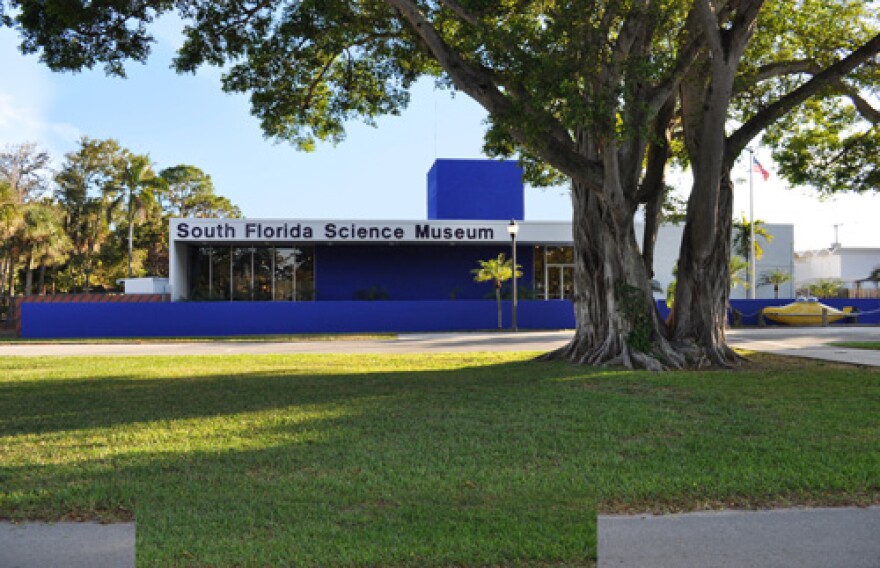What's in a name change? Plenty, when the new moniker also signals an "emotional change," as is the case with the soon-to-be-unveiled South Florida Science Center and Aquarium. The entity is a rebranding of the popular South Florida Science Museum. The longtime Palm Beach County institution hasn't received a makeover since its completion in 1969 (which represents an eternity in a region that is eager to "spruce up appearances" on the regular.)
"It had zero curb appeal," museum CEO Lew Crampton admits of the building. He says the museum's main exhibits "were kind of dark" and many of the amenities were dated. The remodeled space sports a new plaza, grand entrance hall, store, and landscaping, among other features: "It looks completely different...We basically turned the place upside down and created a new science center."
The remodeling/rebranding is part of a $5 million project to overhaul both the building and the mission. The shift from "museum" to "center" isn't arbitrary, but rather, representative of a "broader change."
RELATED: U.S. Lags In Science & Tech Education, While Science Fairs Boom In Palm Beach County
"We're not an artifact-based institution anymore," Crampton says, adding that the new, simplified mission statement -- Open every mind to science -- reflects this point.
The museum has stayed consistently popular throughout the years, Crampton says, particularly with young families. He says "people loved it" despite its flaws and attendance grew to 125,000 visitors a year, plus an additional 55,000 school kids who are served in the community.
While the newly-minted science center hopes to draw a more diverse crowd -- including seniors, tourists, and those without children -- it will maintain a focus on STEM (science, technology, engineering, and mathematics) leadership for kids of all ages. The changes afoot should help to raise the entity from a second tier to first tier operation, Crampton says.
"We're going from being kind of a cozy place for young families to a community based science center that's drawing from a broader population," Crampton says. The target attendance for the first year in operation is 150,000 visitors.
A large chunk of the funding for the expansion and remodeling came from a $2.4 million county grant. The remaining funds were generated through private donations and grants from organizations like the Quantum Foundation (which pledged $900,000), the Batchelor Foundation (which created a "challenge grant" to generate matching funds), and individuals.
Crampton, who joined the museum in late 2010, says the timing of the expansion was a challenge, given the country's economic climate, but persistence has paid off.
"It was not the easiest time to raise money, but we had a great story to tell," he says. "People felt Palm Beach County deserved a great science museum. There is a lot of community support."
When everything is complete, the institution will have grown from 9,500 to 20,000 square feet of exhibition space. That includes a 4,000-square-foot Florida exhibit hall and a 6,000-square-foot traveling exhibition space, which Crampton predicts will host the likes of "Titanic: The Artifact Exhibition" and other big-name draws.

Other additions include 8,000 gallons of fresh water and saltwater aquarium displays with features like a "pop-up" tank (where attendees can experience the sensation of standing among fish), new touch tanks, and displays on both invasive and native species. There's also an eight-foot-tall circular tank filled with nothing but silver fish, which Crampton likens to a kaleidoscope.
"There is a lot of eye candy," he says.
The aquariums were designed and installed by Florida-based company, Living Color Aquariums, stars of the Nat Geo Wild show "Fish Tank Kings." Crampton said the science center's new displays should be featured in an episode of the show to air later this year.
A new Everglades Exhibit Hall highlights Florida flora and fauna in an interactive display, while the River of Grass exhibition details the complicated history of Florida's beleaguered marshlands in an informative, but light-handed approach. A hurricane simulator allows guests to safely experience a storm "at whatever level you want." Other hands-on components include microscopes, "mystery boxes," brain teasers, and puzzles. Many of the old favorites (like the planetarium) will remain, Crampton says, though they will be showcased in a fresh way.
A school science showcase will highlight work by local students on a rotating basis. Meanwhile, Science on a Sphere is a room-sized sphere suspended from the ceiling onto which four computers can project up to 520 programs on everything from real-time hurricane tracking to demonstrations on how tsunamis form. The exhibition was created with data and technology supplied by the National Oceanic and Atmospheric Administration.
The South Florida Science Center and Aquarium will unveil its new look on June 7, with free admission from 10 a.m. to 5 p.m. The current traveling exhibition is "Savage Ancient Seas: The Ancient Aquatic Deep" opening May 17 and continuing through September 16.





